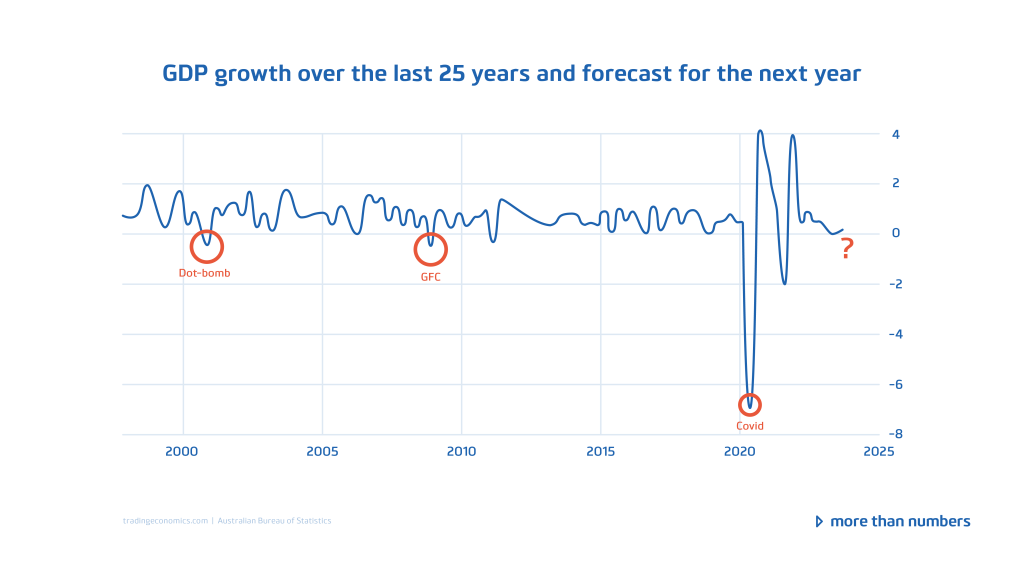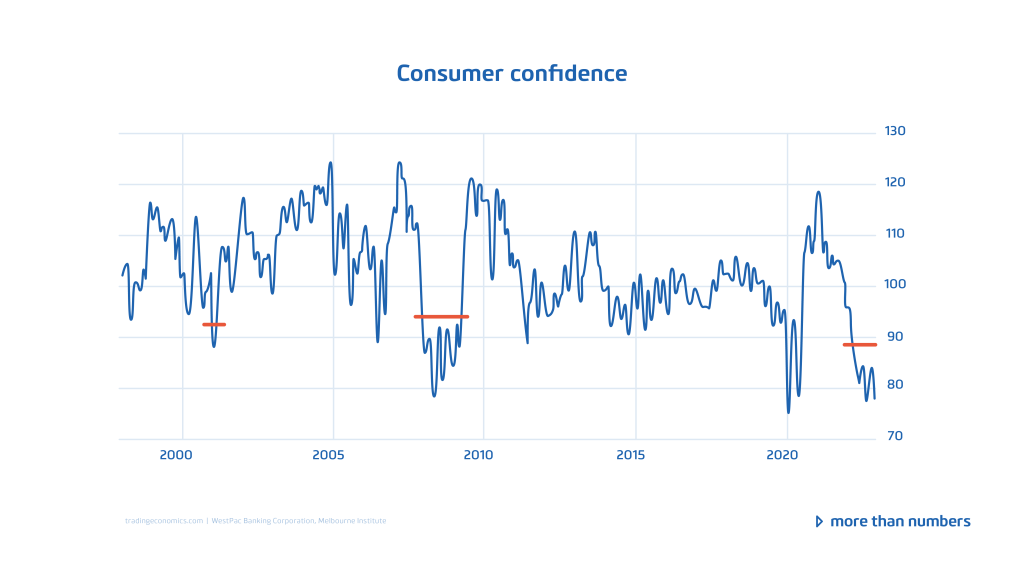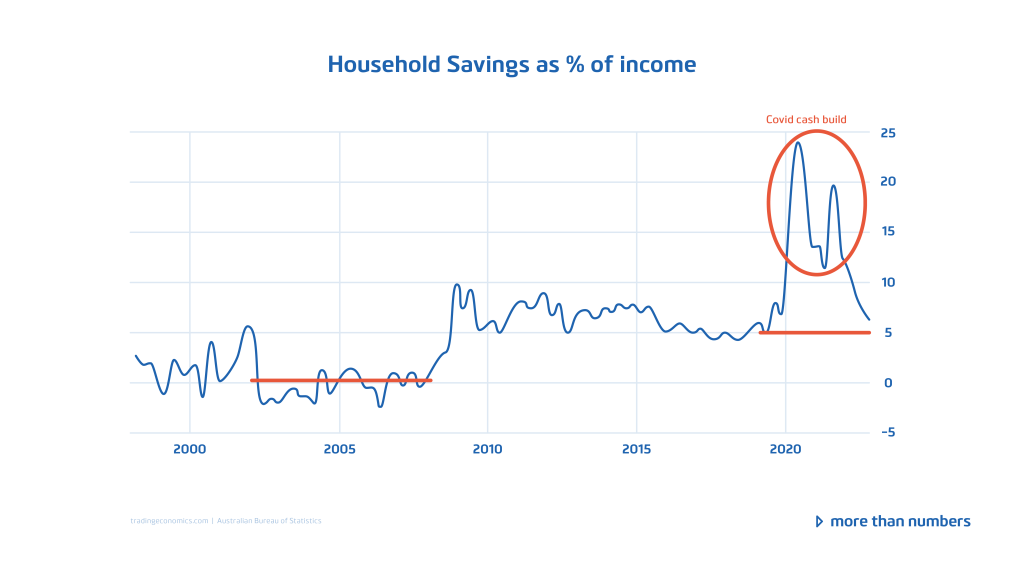By Michael Burke, Director of Strategy at Beyond Advisors
The growth forecasts for the Australian economy are seen to be near zero by the end of 2023 with increasing concerns that the economy could fall into negative territory. Whilst the Reserve Bank of Australia (RBA) is holding firm on its prediction that we will avoid recession, it concedes we are on ‘a narrow path to a soft landing’. Whether our economy falls into recession or not, the next 12 months will feel very different to the year before for businesses.

What is a recession?
According to the RBA, while there is no single definition of recession, it is commonly perceived as a sustained period of weak or negative growth in real Gross Domestic Product (GDP) accompanied by a significant rise in the unemployment rate.
An accepted rule of thumb for characterising a recession is two consecutive quarters of negative GDP growth.
Will the Australian economy go into a recession in 2023?
Overall, throughout 2023, economic growth will continue to slow under the impact of rising interest rates aimed at curbing inflation.
For historical context, Australia had managed to avoid a recession for more than 28 years – including during the GFC – representing the longest period of growth without a recession for a developed country since the establishment of the System of National Accounts in 1953. And, then the Covid-19 global pandemic hit and the Australian economy entered a recession when GDP fell 0.3% in Q1 2020 and a huge 7% in Q2 2020 (the tightest contraction in recorded history).
For comparison, the recession of 1990-91, GDP fell by 1.7%, employment rates fell by 3.4% and unemployment rates rose to 10.8%
While the experts volley back and forth on whether or not a recession in on the cards for 2023 some of the major risks indicating we are heading for an economic slowdown include:
- Inflation has been at high levels just prior to each of the previous slow downs (excluding the unprecedented conditions caused by Covid-19), reaching 6% in the early 2000s dot.com bubble and 5% prior to the Global Financial Crisis of 2007-2009. Currently. inflation is just below 8% and still rising.
- Unemployment has shown the first signs of a move upwards with the unemployment rate increasing for two months in a row – December 2022’s unemployment rate was 3.5% rising to 3.7% in January 2023 – higher than economists expected and the highest level since May 2022 . Combined with falling job vacancy data this may be indicating a softening of the labour market.
- Consumer confidence is at the lowest levels in 30 years. Should this translate into a significant drop in spending, this could be the catalyst for a recession.
- Sales of new homes have stalled in recent months as the impact of the RBA’s rate increases continues to erode market confidence. There is no sign that the market has reached the bottom of this cycle with sales falling in all states across the country and the effect of February’s interest rate rise yet to take full hold and which could prompt further falls.
On the other side of the equation there are factors that could support a soft landing for the Australian economy:
- Households have cash reserves of $300 billion, of which $120 billion is in offset accounts.
- Household savings rates have returned to a more normal 5% of income down from the highs of Covid-19.
- Should consumers choose to dip further into the household war chest and continue spending, we could have the soft landing the RBA is hoping for.
What is the Consumer Confidence Index (CCI)?
The Consumer Confidence Index (CCI) is a survey that measures how optimistic or pessimistic consumers are regarding their expected financial situation. The CCI is based on the premise that if consumers are optimistic, they will spend more and stimulate the economy but if they are pessimistic then their spending patterns could lead to an economic slowdown or recession.
Consumer spending expectations
Major factors impacting the consumers willingness to spend:
- Consumer sentiment historically remains subdued for up to 12 months then rebounds rapidly once consumers feel the worst of it is over.
- Will low confidence be enough to convince consumers to defer spending? What impact has Covid-19 experience had on how consumers feel about delaying spending plans?
- Australians have built up a large cash buffer during the pandemic, their willingness to spend this will have a significant impact on demand forecasts moving forward.


Determining if Australia will experience a recession, or not, will come down to a number of factors, including the way in which the term is defined. Should GDP exhibit two consecutive quarters of negative growth, many will proclaim a recession. But, for other commentators, a more prolonged period of stagnant or negative growth, with a jump in unemployment, will need to happen before they declare a recession.
Regardless of a declaration of recession, Australia, like most of the world, seems destined to encounter some form of economic downturn and weak growth this year. Perhaps a better question than ‘will Australia go into a recession?’ may be ‘to what extent will this forecasted slump affect consumer confidence, and for how long?’. Will the impact be mild and bearable? Or harsh, drawn-out and wide-spread?
Key strategies for an uncertain outlook
With many economic experts speculating that Australia may enter a mild recession by the end of 2023 it’s worth considering your key strategies ahead of time to prevent any major complications.
- Assess the situation on an ongoing basis
- Consumer spending impact on your sales
- Labour cost impact on margins and pricing
- Cash needs impact on inventories and CAPEX
- Assess operational costs and budgets to allow for adjustment
- Debt
- Make a time to discuss your debt and how to best manage this heading towards a slowdown/downturn
- Cash is King
- Businesses with strong balance sheets will better weather the storm
- Quality data and monitoring of situation and performance:
- Take a view and plan for it to be correct, BUT
- Monitor and be ready to pivot
- Business has a clear view of its capabilities and stress test
- Have a business model built on drivers
- Run scenarios to test cash and profit
If you are battling with any of the above issues and would like to discuss how you could better protect your business contact the team at admin@beyondadvisors.com.au or visit our website www.beyondadvisors.com.au